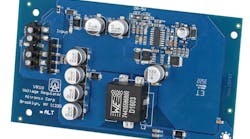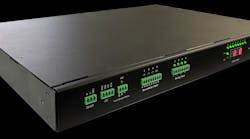The power supply is a critical element in electronic access control (EAC) and video surveillance systems. A faulty power supply can lead to all sorts of problems, including image-quality issues for video surveillance systems, malfunctioning locks, or intermittent operation of accessories or controllers. Of course, the system could shut down if the power supply were to fail.
Power Supply Types
Before discussing how to avoid these problems, it’s important to know the types of power supplies you might work on. These are the following:
Linear: These are the traditional power supply and use transformers. They work well with everything.
Switching: These power supplies don’t use transformers and are lighter and more compact. However, they have a reputation for generating “noise” on the line, which might crash some delicate processors.
PoE: A Power over Ethernet (PoE) power supply uses network cabling to distribute the power and is used extensively for video surveillance systems. I switched from coax cable to CAT5 (now CAT6) and PoE many years ago. A lot of installed video surveillance systems still use coax and non-PoE power supplies. Repairing these systems pays well.
Solar: These power supplies are used with backup batteries and engineered to provide uninterrupted power to homes and appliances, such as gate operators, located where hard-wiring isn’t practical or possible.
Self-regenerative: Although not strictly a power supply, per se, some security equipment, such as door operators, generates its own power to operate.
Battery: Batteries, of course, are used on many stand-alone EAC devices and on video surveillance cameras. Batteries work great on EAC devices, but I’m not a fan of video surveillance cameras that use batteries. When rechargeable batteries are paired with solar panels to recharge them and the battery capacity of the camera power supply tolerates the duty cycle, it will work until there is no sun for a day or two. Keep that in mind if you live in rainy areas.
Hybrid: A hybrid power supply uses multiple technologies to achieve enhanced performance.
UPS: An uninterruptible power supply (UPS), also known as a battery backup, provides backup line voltage power under normal conditions and when the power utility fails or when line voltage drops to an unacceptable level. It also filters transients, or power surges, that exceed a device’s allowable parameters. The size and design of a UPS determine how long it will supply power.
In the Field
When it comes to installing a power supply, there are a few differences when doing a retrofit compared with doing a new installation. Regardless of which, I recommend that you use a dedicated line voltage circuit from the breaker panel of sufficient amperage to power the necessary equipment and don’t exceed the maximum load of the power supply. Also, use a UPS whenever possible.
For retrofits:
Calculate, measure or estimate voltage drops to determine whether the wire is of adequate gauge and the proper type to meet code. Also, make sure the cabling is installed properly. Note how it’s attached above the ceiling, so it stays in place, or how it’s protected beneath the ceiling, so it won’t be affected by normal activity.
For new installations:
The same techniques for retrofits otherwise apply to new installations, but also make sure to use power distribution modules as necessary to isolate each device and prevent catastrophic system failure.
When you install a power supply, you should do the following:
- Locate it in a secure area.
- Locate it in a convenient location for future add-ons and possible troubleshooting.
- Locate it in an unobtrusive location, which would make it less likely to attract vandals.
- Locate it close enough to your equipment, so it doesn’t result in a voltage drop and dysfunctional locks or cameras.
- Locate it so the wiring isn’t close to other voltage-carrying or noise-generating conductors. Also, locate the wiring in a way that will protect it from damage.
Altronix Interview
Altronix is a leader in providing power supplies for EAC and video surveillance. We contacted Ronnie Pennington, Altronix’s director of sales for the Americas, for his insights on power supplies.
Locksmith Ledger: How would you describe the transitions in power supplies that are occurring in the security industry?
Ronnie Pennington: Today’s security systems are generally highly integrated and deploy more devices over larger physical areas. This has dramatically increased the demand for new and innovative power and data transmission solutions that accommodate new-system installations as well as system upgrades that use existing infrastructure.
As a result, Altronix continues to focus on designing and manufacturing products that enable more edge devices to be deployed at longer distances and with more power to accommodate a wider range of applications.
LL: What differentiates a power supply used for EAC from one that’s used for video?
Pennington: Nowadays, most new video surveillance installations employ IP cameras that accept PoE from 15 watts up to 90 watts for the high-powered pan-tilt-zoom (PTZ) cameras. Access control devices typically operate on 12VDC or 24VDC and require less wattage, with many new IP locking devices requiring PoE.
To accommodate these new trends, Altronix offers both 12VDC and 24VDC power options as well as myriad PoE options.
LL: What are your most popular EAC power supplies?
Pennington: Altronix Trove access and power integration solutions allow system designers and installers to easily combine Altronix power distribution with access controllers from brands such as Mercury, CDVI and more. This provides a single point of maintenance and service while minimizing wall space.
Trove is a scalable solution, available in wall- or rack-mount configurations that support two-door access systems up to 36 doors, which streamlines system design and deployment.
LL: What are your most popular video power supplies?
Pennington: This would be dependent on the infrastructure in place or the type of devices to be powered. One of Altronix’s trending solutions is its NetWay Spectrum line of hardened PoE switches and Ethernet-to-fiber media converters that allow the deployment of multiple IP devices in remote locations with or without local power. These products support the latest PoE devices, such as wireless access points, high-powered PTZ cameras, illuminators and more at longer distances by using a fiber infrastructure.
LL: With IP taking over, what are the considerations for selecting PoE power supplies?
Pennington: The first thing that has to be determined is how much power the device or devices will draw: 15W (802.3af), 30W (802.3at), 60W (High-PoE) or now 90W (802.3bt).
Altronix provides PoE midspan or injectors, hardened switches and media converters that support all these PoE standards.
More info: www.altronix.com
Further possible power supply solutions include the following:
Securitron AQL series
The AQL Series of switching access control power supplies is an out-of-the-box solution that’s feature-rich, network-management ready and available in 12 or 24VDC single, dual and multivoltage units.
AQL4 Series power supplies are dual voltage and UL listed, plus they’re multivoltage- and network-monitoring-ready through optional modules. The Netlink module allows for remote management, control and testing of the power supply and will send email and text alerts of potential problems.
AQL4 power supplies are field-selectable with a dedicated fast battery charger to prolong battery life. They provide 4 amps at 12VDC or 3 amps at 24VDC and are expandable up to 16 outputs. Their OutSmart technology provides dual-color LED visual notification, which prevents applying the incorrect voltage to the power supply: green at 12V, blue at 24V.
Their low-battery cutoff protects batteries from a deep discharge, and they have enhanced surge immunity for input/output protection.
More info: www.securitron.com
SDC Power Supplies
SDC power supplies have been developed specifically to support EAC locking hardware with clean, consistent power. When combined with SDC’s door controllers, they provide a convenient and reliable way to install power for virtually any door control application. The circuitry design is aimed at the inductive loads generated by EAC hardware for high performance and longevity. The modular design is built around several different control modules to meet the most demanding component interface and control logic requirements.
SDC offers 12/24VDC class 2 linear power supplies in the following sizes: 1 amp, 1.5 amps, 2 amps, 4 amps and 6 amps.
More info: www.sdcsecurity.com
DITEK DTK-UPS Series
DITEK’s DTK-UPS Series of UPS models enable equipment to survive even the harshest power quality issues. From surges and spikes to brownouts and complete power loss, the DTK-UPS Series will keep equipment up and running. The DTK-UPS series provides cost-effective and reliable performance for network servers, video surveillance systems and more.
More info: www.diteksurgeprotection.com
Tim O’Leary is an experienced security consultant and a regular contributor to Locksmith Ledger.







